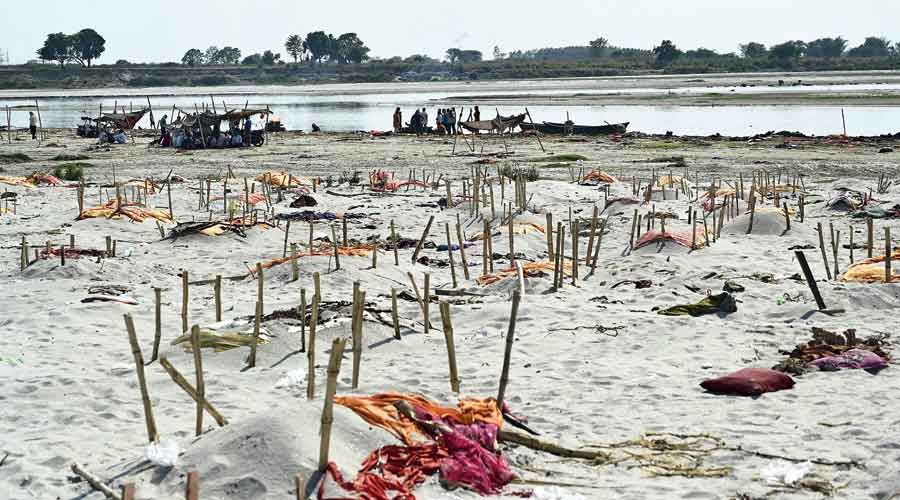It was three weeks ago when journalists combing obituary pages in Prime Minister Narendra Modi’s home state of Gujarat found authorities were concealing Covid-19 deaths that people started asking hard questions about the real number of Indian coronavirus fatalities. Now, epidemiologists and scientists around the world are struggling to solve the question.
The latest to enter the fray is top epidemiologist Bhramar Mukherjee, who holds the biostatistics chair at the University of Michigan. She calculates that 1.2 million Indians had died and 495 million had been infected by the virus up to mid-May. These fatality and infection totals contained in her preprint study, meaning it still must be peer-reviewed, are vastly higher than the government’s numbers which showed a cumulative 25 million Covid cases and 270,000 deaths on May 15.
“I’ve tried to be very conservative in terms of the assumptions we’ve made in the mathematical model. If anything, I should be criticised for being conservative,” says Mukherjee, who started tracking and seeking to predict the pandemic’s trajectory back in March 2020.
Mukherjee says actual deaths could be far higher. “We do not capture all the Covid-related deaths,” she says, adding, “We have so many cases where people have got to the hospital but the final cause of death assigned is not Covid. If you take the direct impact, our models tell us that five times more people have died,” she told TV anchor Barkha Dutt in an interview on Mojo Story.

We have so many cases where people have got to the hospital but the final cause of death assigned is not Covid.
Covid deaths of people with co-morbidities are often being excluded from official data, even though the Indian Council of Medical Research (ICMR) guidelines stipulate the virus should be listed as the cause of death and co-morbidities should be classified as “other significant” contributing conditions.
In rural areas, which has been swept by Covid-19, overwhelming the extremely weak health infrastructure, there is little testing so many coronavirus deaths are not being attributed to the virus. A 30-person Dainik Bhaskar reporting team earlier in May photographed over 2,000 bodies along a 1,140km stretch of the Ganges buried in shallow graves and bobbing in the water.
Mukherjee’s study has looked at the two Covid-19 waves that have hit India. “We’ve broken it up into Wave 1 and Wave 2 and we distinctly see the underreporting (of deaths) is much more acute in the Wave 2 phase,” she says.
The estimated 495 million coronavirus total infections would mean 36 per cent of the 1.36 billion population had had the illness till May 15. Mukherjee believes India has crossed Wave 2 peak and that the number of infections is now trending downwards nationally, although cases may be yet to peak in certain states.
“The (national) peak passed two-to-three weeks ago. Four weeks ago, things were more extreme and folks are also seeing that.” She adds a warning, though, saying: “Are we out of the woods yet? I don’t think so.”
Underreporting factors
On the undercounting of cases, Mukherjee notes that on May 15 when the study estimated the cumulative total of infections stood at 495 million, the government was reporting a figure of 24.8 million. “That gives you an underreporting factor of about 20 for the number of cases.”
Similarly, on deaths, the government reported a total of 270,000 on May 15 when the study calculates there were around 1.2 million fatalities. “Again, that gave us an (overall) underreporting factor of about four to five,” says Mukherjee.
The study estimated the underreporting factor for cases during the first wave from April 1, 2020, to January 31 of this year at 11.11 and for deaths at 3.56. For the ongoing second wave, starting on February 1 and finishing on May 15 for the purpose of the study, the researchers calculated the under-reporting factor at 26.73 for infections and 5.77 for deaths.

Are we out of the woods yet? I don’t think so.
Most experts agree
Internationally, most experts concur that the government’s case and fatality toll are much lower than the actual numbers. The New York Times has offered best-case and worst-case scenarios that differ sharply from the government. Its “conservative” estimate could have been 404.2 million infections and 600,000 deaths in India.
Under what the newspaper calls the “more likely scenario,” there have been 539 million infections and 1.6 million deaths. Its worst-case scenario estimates 700.7 million infections and 4.2 million deaths. The Union government has blasted the newspaper’s estimates as “absolutely false” and having “no basis at all.”
Similarly, The Economist says undercounting has been rampant in India and that the real caseload could be ten or even 30 times higher and the number of deaths much more too both in India and across Asia and Africa. And the Washington-based Institute for Health Metrics and Evaluation reckons that by end-July 1.1 million Indians will have died from Covid-19.
Mukherjee’s study offers much more conservative estimates than Professor Ashish Jha, dean of the Brown University School of Public Health, who said in early May when crematoriums were being overrun that anywhere between 25,000 to 50,000 Indians could by dying daily from the coronavirus and that the true number of infections daily was anywhere between two to five million.
To arrive at their conclusions, Mukherjee and the other researchers first estimated the underreporting factor for infections from publicly available data released by ICMR on the reported number of cases and national seroprevalence surveys. The researchers then used an epidemiological model to estimate the undetected number of infections and deaths.
Mukherjee cautions that there are variations from state to state and that it may present a false picture to talk of infections peaking nationally. “The concept of a national peak makes me feel a little anxious because it gives everybody this sense of false security that the crisis period is over.”

Bhramar Mukherjee
Bengal, TN among worry states
She points towards a high level of infections still in states like West Bengal, Tamil Nadu, Karnataka, Andhra Pradesh and emerging clusters in the northeast, Goa and Lakshadweep. “This image that we are out of the woods really concerns me. No one is safe till everyone is safe,” she says.
The researchers qualify their findings with several caveats, noting that they do not have a “rigorous way” to validate the extent of under-reporting of deaths and that the figures are incomplete as the second Covid-19 wave is still ongoing. They also note “considerable variation in these (infection and death) estimates across Indian states.”
Seroprevalence surveys and epidemiologic models “agree on the estimated infection fatality rate for India” for the first wave but up-to-date serosurvey and excess death/mortality data are needed to validate” the second wave and the combined estimates, the researchers add.

No one is safe till everyone is safe.
Lower fatality rate
India on Sunday officially reported 2,722 Covid-19 deaths, the first time in 34 days that the number had fallen below 3,000. Total new cases were 153,663, marking the lowest daily count in 50 days.
The University of Michigan figures do suggest an element of good news: India appears to have a lower infection fatality rate of around 0.25 per cent. According to the study, an analysis of infection fatality rates across the globe puts the mean figure at 0.68 per cent and the average at 0.27 per cent. If the study were to rely only on officially reported deaths, the infection fatality estimate would be 0.13 per cent for the first wave and 0.03 per cent so far for the second wave.
The perceived reduction in fatality rates during the second wave could be primarily due to two reasons, the researchers say. “One is that we do not have the same length of the follow-up period and complete data on the second wave. The second could be the different age composition of the infected populations in the two waves,” they said.
India’s young population
The younger population reportedly got infected in larger numbers in the second wave and a fraction of the older population (aged 65+ years) also got vaccinated during the second wave, the researchers say.
India has a very young population with only 6.4 per cent in the 65-plus age group compared to the US where this proportion is 16.5 per cent “so a comparison of overall infection fatality rate between India and, say, the US is not fair,” the study authors say. “Only age-specific IFRs (infection fatality rates) should be calculated and compared when more data become available,” they said.
The researchers also cautioned that their hypothesis about reduced fatality rates in the second wave “cannot be verified without more granular, age-sex stratified nationwide time-series data on the case and death counts, which is currently unavailable.”
If the government released its historic and excess mortality data from India it would be possible to calculate the direct effect of coronavirus on fatalities more exactly, Mukherjee said. “The UK and US have also done this calculation to assess the direct and indirect impact of Covid on mortality. And there is a way to verify this assumption if you do have the right data,” she said.










